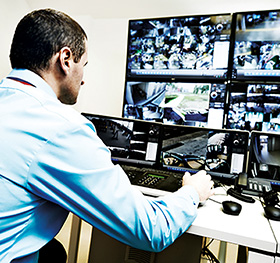

Video surveillance systems have been around for decades with the primary aim of protecting people and property. However, the advancement of video analytics has created a plethora of new opportunities for IP surveillance systems.
Going IP is a smarter way for video to be captured, accessed, reviewed, interpreted and stored. Video analytics software analyses and interprets these images. It supports operators by being their eyes and ears and doing the tasks that are either beyond most humans, or would take hours, days or weeks of manpower. The software can analyse every single frame of footage for extraordinary events as they happen, which allows operators to make better, more informed decisions.
The real-time benefit
With the untapped potential of video analytics, it should not be underestimated just how much this technology is strengthening security. The ability to create rules and to receive alerts in real time means that action can be taken, and the authorities informed, as incidents are taking place.
For example, KEPCO, a Japanese utility company, needed to resolve the issue of trespassing around its dams. There had been a number of fatalities as a result of drowning when water was discharged from its dams. In order to prevent
further tragedies, KEPCO invested in a surveillance system that it manages remotely using Milestone XProtect Professional Video Management System integrated with Agent Vi’s savVi video analytics.
Real-time detection capabilities provide a way to safeguard the unmanned, remotely monitored dam sites. Most important, it allows the operators to take decisive action, which includes a loudspeaker system to proactively warn trespassers of the dangers and to leave.
Analytics without the hefty price tag
There are two methods which allow analytics to be implemented: it can be installed centrally on the video management software server, or it can be incorporated into the camera itself, known as the edge (device on the network). Edge technology removes the need for backend server infrastructure which has significantly driven down the cost of this technology making video analytics much more accessible.
The applications of video analytics are still underutilised and underestimated. More industry sectors are adopting the technology, but how it can and will be used will continue to evolve. An open platform video management system (VMS) allows the customer to choose the solution that will work best for their needs.
Intelligent video applications
There are a host of technologies that will forge an increasingly important role for analytics. These include the growth of the Internet of Things (IoT), big data, and Deep Learning (a subset of Machine Learning) which facilitates applications such as facial recognition. There are already a large number of industry sectors joining the analytics revolution and reaping further benefits in addition to security.
Nowhere is this more apparent than in the retail sector. Retailers can achieve tangible results from the business intelligence (BI) that analytics provide. More than being a key tool in their loss prevention strategies, it is also valued as a means to improve the customer experience and to optimise store layouts.
The VMS plays an important role. It is not only an administrative function and the ‘safe-keeper’ of video data, but also an integrating function. If the VMS is a true open platform, it allows more than one analytic function to run concurrently. This enables customers to adapt their video systems to their changing needs.
For example, a retailer could heat map in-store customer behaviour, have another solution monitoring queue length at the checkouts, and a third running facial reaction tracking measuring the efficiency of digital signage.
By analysing video and recognising patterns, analytics management systems can determine key information such as footfall, and where the prime spots are in the store to optimise sales. Rather than purely being the domain of the security department, the video analytics software delivers valuable information and insights into customer habits and behaviour to the merchandising, procurement and marketing teams.
These capabilities can be applied to many other industry sectors – from healthcare to transport, to city surveillance, banking and leisure. It is the ability of analytics to interpret patterns in behaviour that allows end-users to make sophisticated decisions about their organisations and assets.
As the adoption and installation of surveillance systems continues, end-users will want to harness the maximum potential of their systems to derive the best return on investment. This is where video analytics excel.
| Tel: | +27 10 500 8793 |
| Email: | [email protected] |
| www: | www.milestonesys.com |
| Articles: | More information and articles about Milestone Systems |

© Technews Publishing (Pty) Ltd. | All Rights Reserved.